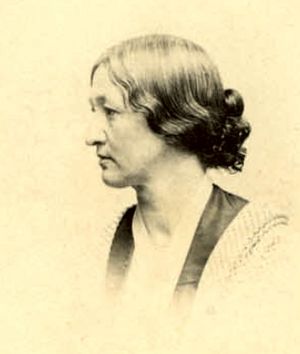Elizabeth Smith Miller facts for kids
Quick facts for kids
Elizabeth Smith Miller
|
|
|---|---|
 |
|
| Born |
Elizabeth Smith
September 20, 1822 Peterboro, New York, U.S.
|
| Died | May 23, 1911 (aged 88) Geneva, New York, U.S.
|
| Occupation | Advocate and philanthropist |
| Spouse(s) |
Charles Dudley Miller
(m. 1843; died 1896) |
| Children | 4 |
Elizabeth Smith Miller (born Smith; September 20, 1822 – May 23, 1911) was an American woman who strongly supported women's rights. She also gave money to help the women's rights movement grow. People often called her "Libby."
Early Life and Family
Elizabeth Smith was born on September 20, 1822, in Peterboro, New York. Her father was Gerrit Smith, who worked to end slavery. Her mother was Ann Carroll Fitzhugh, who also fought against slavery.
In 1843, Elizabeth married Charles Dudley Miller. They lived in a small house on her father's large property in Peterboro. Later, their son, Gerrit Smith Miller, lived there. The family eventually moved to Geneva, New York. Elizabeth Smith Miller passed away there on May 23, 1911, when she was 88 years old.
Working for Women's Rights
Elizabeth Smith Miller was an important leader in the women's rights movement. She attended the third National Women's Rights Convention in Syracuse, New York. At this meeting, she suggested creating women's rights groups in each state. This idea was accepted when a plan for a national group did not pass.
She also helped start the National Woman Suffrage Association. This group worked to get women the right to vote. She founded it with other famous leaders like Elizabeth Cady Stanton and Susan B. Anthony.
Writing and Books
After her father died in 1874, Elizabeth Smith Miller worked on a book about his life. She worked with an author named Octavius Frothingham.
In her later years, she wrote a book about home economics. This book gave advice on managing a household.
The "Bloomers" Outfit
Elizabeth Smith Miller believed that women's clothing should be more comfortable and practical. She was a supporter of Victorian dress reform. She was one of the first women to wear a new style of clothing. This outfit included loose pants, called Turkish pantaloons, worn under a knee-length skirt.
This new style was later made popular by Amelia Bloomer in her newspaper, The Lily. The outfit became known as "Bloomers." It was similar to clothes worn by women in the Oneida Community.
Leaders of the women's rights movement wore "Bloomers" to show their desire for change. They felt that traditional women's clothing was too restrictive. It made it hard for women to move freely and take part in many activities. Wearing "Bloomers" was a way to protest against these limits. However, the outfit got so much attention that it started to distract from the main goals of the women's rights movement. Because of this, many leaders eventually stopped wearing them.


